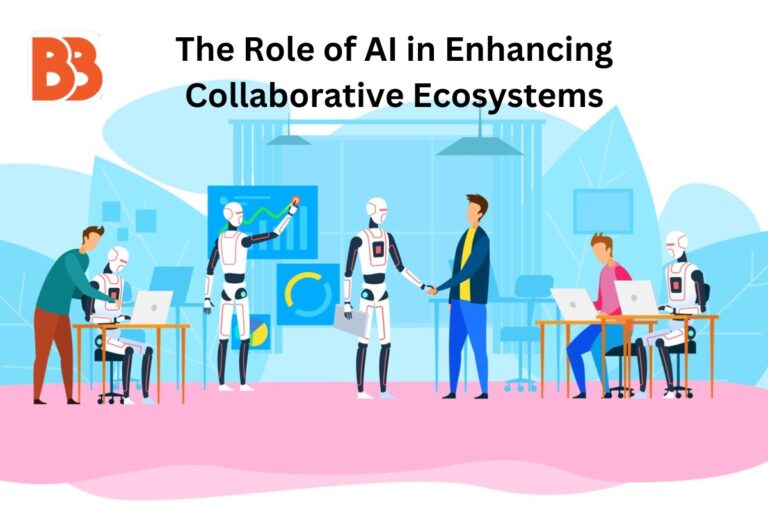Enter Artificial Intelligence (AI) a transformative force that is revolutionizing how collaborative ecosystems function, scale, and succeed. However, as these networks grow in size and complexity, managing them becomes a monumental challenge. These ecosystems thrive on shared goals, mutual trust, and the seamless exchange of ideas and resources. Let’s dive into this article to explore how AI is reshaping collaborative ecosystems, its applications across various sectors, and the challenges and opportunities that lie ahead.
What Are Collaborative Ecosystems?
A collaborative ecosystem is a dynamic network of interconnected entities—individuals, organizations, or even machines—working together toward shared objectives. These ecosystems exist in various domains, from business consortia and research alliances to social movements and cross-industry partnerships. What sets them apart is their reliance on collective intelligence, resource-sharing, and the ability to adapt to ever-changing circumstances.
However, collaborative ecosystems often face significant hurdles:
- Complex Coordination: Managing diverse stakeholders with different priorities and expertise.
- Information Overload: Handling vast amounts of data and extracting meaningful insights.
- Resource Optimization: Ensuring that resources like time, money, and talent are utilized effectively.
AI: The Ultimate Enabler of Collaboration
AI enhances collaborative ecosystems in several ways, enabling smarter, faster, and more effective collaboration. Let’s dive deeper into the key roles AI plays:
Facilitating Seamless Communication
One of the foundational elements of any collaborative ecosystem is effective communication. Misunderstandings or delays in exchanging information can hinder progress. AI addresses this through:
- Real-Time Translation: AI-powered tools like Google Translate enable teams from different linguistic backgrounds to communicate effortlessly.
- Summarization and Insights: Platforms like Otter.ai use natural language processing (NLP) to summarize meetings and highlight key points, ensuring everyone stays aligned.
- Conversational AI: Chatbots and virtual assistants enhance real-time collaboration by answering queries, scheduling meetings.
Streamlining Resource Allocation
Resource management is critical in collaborative ecosystems. AI optimizes resource allocation by analyzing data, predicting demand, and identifying inefficiencies. Examples include:
- Supply Chain Optimization: AI tools like IBM Watson analyze supply chain data to minimize waste, reduce costs, and ensure timely delivery of goods.
- Shared Resource Platforms: AI-driven platforms like Airbnb and Uber optimize resource-sharing by matching supply with demand in real time.
Whether it’s distributing funding in research collaborations or managing assets in urban ecosystems, AI ensures resources are used effectively.
Enhancing Decision-Making
In ecosystems involving multiple stakeholders, decision-making can be slow and fraught with disagreements. AI accelerates this process by providing data-driven insights that guide decisions:
- Predictive Analytics: AI models forecast trends, enabling proactive decision-making. For instance, in healthcare ecosystems, AI predicts disease outbreaks, guiding resource deployment.
- Simulations and Modeling: AI-powered simulations help stakeholders evaluate different scenarios. Urban planners, for example, use AI to model the impact of new policies on traffic, pollution, and housing.
Driving Innovation
Collaborative ecosystems thrive on innovation, and AI is a powerful catalyst for creativity and problem-solving:
- Uncovering Trends: AI analyzes market and social data to identify emerging trends and opportunities. Platforms like Trendalytics help fashion and retail brands collaborate on seasonal collections.
- Accelerating Research: In collaborative R&D ecosystems, AI tools like AlphaFold (used in protein folding research) enable breakthroughs by analyzing vast datasets faster than humans ever could.
Scaling Ecosystems with Automation
As ecosystems grow, scaling operations becomes a challenge. Manual processes can’t keep up with the increasing complexity. AI solves this through automation:
- Workflow Automation: Tools like Zapier and UiPath streamline repetitive tasks, freeing up human collaborators to focus on strategic goals.
- AI-Powered Monitoring: In large ecosystems like smart cities, AI systems monitor infrastructure, traffic, and environmental conditions, ensuring smooth operations.
By automating mundane tasks, AI allows ecosystems to scale without compromising efficiency.
Real-World Applications of AI in Collaborative Ecosystems
AI’s impact on collaborative ecosystems is already visible across various sectors:
Climate Action Networks
Climate change is a global challenge that demands collaboration on an unprecedented scale. AI-powered platforms like Climate TRACE monitor greenhouse gas emissions using satellite imagery and machine learning. This data enables governments, NGOs, and businesses to collaborate more effectively on emission reduction strategies.
Healthcare Ecosystems
In healthcare, collaborative ecosystems involving hospitals, research institutions, and governments are leveraging AI to improve outcomes. For example:
- IBM Watson assists doctors in diagnosing diseases and suggesting treatments.
- AI algorithms identify patterns in patient data, accelerating drug discovery and clinical trials.
Smart Cities
Urban ecosystems benefit immensely from AI. Smart city platforms use AI to optimize traffic flow, manage waste, and enhance public safety. For instance, Barcelona’s smart city initiatives rely on AI to analyze data from IoT sensors, enabling better resource allocation and citizen services.
Education and Learning Communities
AI fosters collaboration in education by personalizing learning experiences and connecting students and educators worldwide. Platforms like Coursera and Duolingo use AI to recommend courses, facilitate peer interactions, and provide real-time feedback.
Challenges in AI-Driven Collaboration
Despite its promise, the integration of AI into collaborative ecosystems is not without challenges:
- Data Privacy and Security: Sharing data across stakeholders raises concerns about confidentiality and compliance with regulations like GDPR.
- Bias in AI Models: AI systems can inadvertently reinforce biases if trained on unrepresentative datasets, leading to unfair outcomes.
- Resistance to Automation: Stakeholders may distrust AI-driven systems, particularly in decision-making processes that were traditionally human-led.
Addressing these challenges requires careful design, transparency, and continuous monitoring of AI systems.
The Future of AI in Collaborative Ecosystems
Looking ahead, the role of AI in collaborative ecosystems will only grow. Emerging trends include:
- Integration with Blockchain: Combining AI with blockchain can enhance transparency and trust in ecosystems, particularly in finance and supply chains.
- AI-Driven Personalization: Collaborative platforms will increasingly use AI to tailor experiences to individual users while maintaining ecosystem-wide harmony.
- Human-Machine Collaboration: Future ecosystems will involve closer collaboration between humans and AI, leveraging the strengths of both to solve complex problems.
The fusion of AI with technologies like IoT, augmented reality, and quantum computing will unlock new possibilities for collaboration, enabling ecosystems to tackle challenges we can’t yet imagine.
Conclusion
AI is not just a tool it’s a partner in enhancing collaborative ecosystems. By facilitating communication, optimizing resources, driving innovation, and scaling operations, AI empowers ecosystems to reach new heights of efficiency and effectiveness. However, as we embrace AI-driven collaboration, we must address ethical, privacy, and bias concerns to ensure that these systems benefit everyone involved. In the end, AI’s role in collaborative ecosystems is about amplifying human potential. By breaking down barriers, connecting diverse stakeholders, and unlocking new opportunities, AI is helping us collaborate in ways that were once the stuff of dreams.
Read More:
The Role of AI in Strengthening Post-Quantum Cryptography
Future Trends: The Evolution of AI in Predictive Analytics and Data Insights

